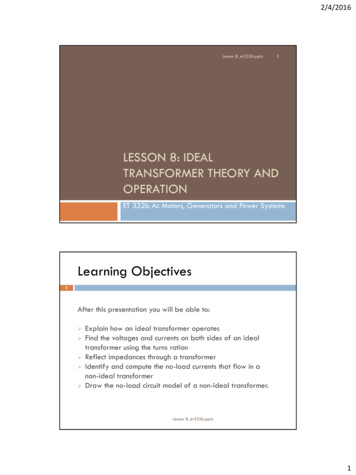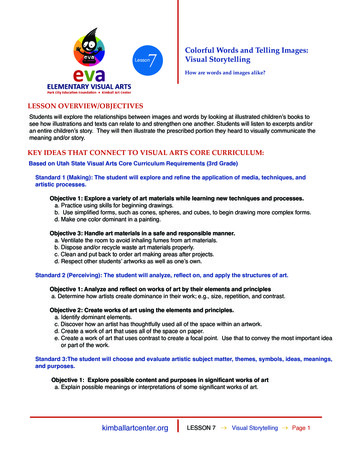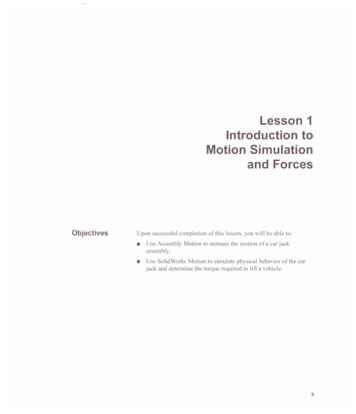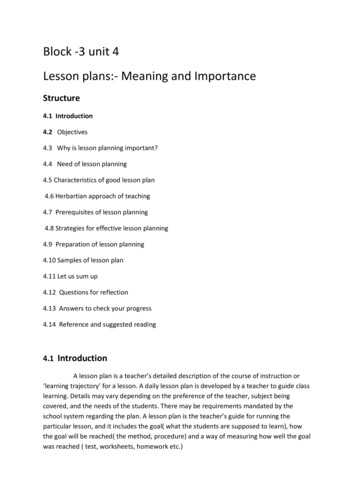
Transcription
c01IdeatingandConceptualizingaGame.indd Page 1 23/03/13 11:09 AM user/208/WB00843/9781118359891/ch01/text sIdeating andConceptualizinga GameLE SSON1E X A M O B J E C T I V E M AT R I XSKILLS/CONCEPTSMTA EXAM OBJECTIVEMTA EXAM OBJECTIVE NUMBERIdeating a GameDifferentiate among game types.Differentiate among game genres.Understand the different gameplatforms.1.11.22.5Creating the Game ConceptUnderstand player motivation.1.3KEY TERMSarcademission statementcontrollersmobile devicegame conceptmotivationgame mechanicsmultiplayer gamesgameplayoffline gamesgame settingonline gamesgame typesingle player gamesgenrestorylinehandheld game consoletarget audiencemassively multiplayer online role-playinggame (MMORPG)user interface (UI)FunGaming Inc., is a game development start-up company. The goal of the company isto research the gaming needs of individuals across the world and make gaming productsthat exhibit an innovative design, addictive gameplay, stunning graphics, and leading-edgetechnology. The organization is currently in the process of ideating and conceptualizingone such product. During this phase, the project team identifies the game’s target audience and decides the game type and genre accordingly. The team then creates the gameconcept, which includes the mission statement and storyline of the game, gameplay, andgame mechanics.LICENESEDPRODUCT NO FOR SALE1
c01IdeatingandConceptualizingaGame.indd Page 2 23/03/13 11:09 AM user/208/WB00843/9781118359891/ch01/text s2 Lesson 1 Ideating a GameTHE BOTTOM LINEIdentifying the idea of a game is the first step in the game development process. The ideafor a game encapsulates defining the motivation for the set of players you are targetingand deciding the genre and platform that is most appropriate for those players.Games are one of the means of social interaction across all human cultures. Digital gamesare a new face of this age-old method of social interaction. Developing an interesting game isa challenging task. It might appear daunting at first, especially if you want to create a gamesimilar to the ones available off-the-shelf, complete with complex animations and elaborateprogramming. However, if you follow a set procedure and consider a few elements of thegame concept, the complexity of the process reduces considerably.A good game begins with a strong idea, which comes from understanding what motivatespeople for playing games.Identifying the MotivationIdentifying the motivation behind playing games involves finding the reasons why peopleplay video games.Playing video games has become a universal trend. People play and get addicted to the gamesthat satisfy some of their basic needs. As a game developer, you should first identify thosebasic needs. The next step is to identify the selective needs of the players that you want tofulfill through your game.Playing games satisfies three psychological needs of people: achievement, recognition, andsatisfaction. People enjoy the challenges of a mentally stimulating game and are extremelydelighted when they achieve the goals of the game. By winning the game, they earn recognition and respect from others. This in turn gives them great satisfaction.Games also satisfy one of the most important emotional needs of people: the need to connect and interact with others. Games enable social interaction across geographical andcultural boundaries.These psychological and emotional needs manifest into one or more of the following basic needs: QuestLearningTask managementDeterminationCompetenceThrillQUESTOne benefit that encourages people to play video games is that they can gain new knowledgeand skills. For example, novice cricket or basketball players might want to play a video gameLICENESEDNOSALEto experiment with newPRODUCTstrategies on the screenbeforeFORtrying themout on the field. Thishelps them to improve their performance when they implement the strategy on the field andmentally prepares them to face their opponents with clear resolutions.
c01IdeatingandConceptualizingaGame.indd Page 3 23/03/13 11:09 AM user/208/WB00843/9781118359891/ch01/text sIdeating and Conceptualizing a Game 3LEARNINGGood video games provide an excellent learning environment by providing personal controland autonomy to players. Players can explore new topics and learn to deal with the challengesimposed by video games by experimenting with their actions without worrying about theconsequences. The losses sustained in making a mistake in a game world are much less significant than those sustained in the real world. This in turn provides self-confidence, which is akey ingredient of the learning process.TASK MANAGEMENTVideo games involve resource and attention management. Players plan and track goals andsubgoals, all in pursuit of winning the game. Identifying and managing the game tasks successfully provide the players with a sense of achievement.CHALLENGEChallenges in the game play a key part in motivating the players. However tough the challenge, hard-core players might not be willing to give up until they achieve the game’s goal.Progressing through the different game levels can be annoying. With constant perseverance,players achieve the predefined game goal and feel proud of their achievement.COMPETITIONVideo games provide an outlet to the players to compete by overcoming interesting challenges. This not only fulfills the basic need for competition but also helps to determine andproclaim how competent the winner is in handling a given challenge. Additionally, the gameencourages players to compare their gaming achievements with their peers and decide the bestplayer among them.THRILLVideo games can simulate situations that players might never experience in real life. In a virtual world, everyone can be a hero and save a victim from the villain by shooting the villainin the head. Or a player may be able to act as a detective and solve the most difficult case better than Sherlock Holmes himself. Or an earthquake victim can experience the thrill of finding a way out of a devastated city. Or a Formula 1 driver can win a close race. These experiences thrill the players and satisfy their need for exploring the unimaginable.Identifying the Target AudienceThe game motivation varies with the type of players. While ideating for a game, it isimportant to identify the target audience or group of people for whom the gameis meant.To develop an effective game for a given audience, it is essential to become familiar with thelikes and dislikes of your target audience. The target audience for games can be distinguishedbased on age and gender. Based on age, players are categorized into preschoolers, children,teens, and adults. Based on gender, players can be male or female. Players can also be dividedinto groups based on demographic factors, such as geographical location, nationality, culture, and religion. Each of these player groups have different needs and motivational levelsto play games.LICENESEDPRODUCTFORSALEBased on the needsand motivational NOlevels, theaudiencefor games can be further dividedinto casual players, hard-core players, intermediary players, and professional players. Let uslook at this variety of players in more detail.
c01IdeatingandConceptualizingaGame.indd Page 4 23/03/13 11:09 AM user/208/WB00843/9781118359891/ch01/text s4 Lesson 1CASUAL PLAYERSCasual players are people who: Have limited interest in playing games Do not spend much time playing games Prefer to purchase easy games and buy difficult games rarely, only if they are influencedCasual players are older and mostly female. However, given that this group likes easy games,developing games for casual players might not require much use of your creativity and intellect.Casual players play games such as Jawbreaker, Minesweeper, and Solitaire.HARD-CORE PLAYERSHard-core players are people who pursue games seriously. They are people who: Have a passion for gamesLike to play high-level or challenging gamesTend to play more involved games that require more time to completeTend to compete in tournaments and leaguesHard-core players do not attempt to purchase easy games because they are rigid due to theirhigh expectations. With their high demand, they prompt your creativity and progression bykindling new ideas and creative solutions. Hard-core gamers play games such as Halo: CombatEvolved Anniversary, Forza Horizon, and Metal Gear Solid 4.INTERMEDIARY PLAYERSBoth casual players and hard-core players are two extreme customers in the gaming industry.In contrast, intermediary players are in the middle, between the casual and the hard-coreplayers. The intermediary players are people who: Have an interest in diverse gamesSpend less time playing games compared to hard-core playersLike to play games that are neither too easy nor too difficultDo not intend to take part in competitionsPlayers in the age group of 16 to 22 years around the world fit well into this category. Developinggames for intermediary players involves creating balanced games that are not too simple or toocomplex. This enables maintaining the balance in terms of both creativity and profitability.Intermediary players play games such as Quantum Redshift, Kinect Adventures, and Kinect Sports.PROFESSIONAL PLAYERSProfessional players are hard-core players who play games to earn money. Many companiespay these players for testing the games developed by them. Game testing is now an importantline of business in the games industry.Identifying the Game GenreCERTIFICATION READYWhich game genre doyou suggest if your targetaudience consists ofchildren in the age groupof 10 to 14 years?1.2Video games are classified into various genres based on the type of player’s interactionwith the game called gameplay.LICENESEDNOFORSALEFor instance, cinemaThe word genre refers toPRODUCTa particular class or typeof anartistic venture.has different genres, such as action, comedy, and romance. Similarly, you can also categorizegames into different genres.
c01IdeatingandConceptualizingaGame.indd Page 5 23/03/13 11:09 AM user/208/WB00843/9781118359891/ch01/text sIdeating and Conceptualizing a Game 5You decide the genre of the game based on the motivation and the target audience identifiedfor the game. For example, young children play games for fun, which enables them to learnconcepts such as counting and spelling. These games belong to the educational games genre.An example of an educational game is The Magic School Bus in the Time of the Dinosaurs.Besides the educational games genre, other genres include the following: ActionAdventureSportsSimulationRole-playing game (RPG)FantasyCardBoardACTIONAction games, as the name suggests, focus on warfare. In this game genre, players make rapidmoves to carry out attacks on targets. Players need spontaneous and quick reactions to overcomegame challenges. Two subtypes of this genre are the shooter game and the fighting game.A shooter game involves destroying all opponents using some sort of weapon, usually a gun orsome other shooting weapon. The aim of this game is that the shooter or the player characterremains alive throughout the mission. There are two viewpoints through which the playercan view the events in this game. Based on these viewpoints, the shooter game genre furtherdivides into the following: First-person shooter (FPS) genre: In FPS, the player can view the events through theshooter character’s eye. Halo 4: Forward Unto Dawn is an example of the FPS subgenre(see Figure 1-1). Though a stealth action game, it can be played at many places with afirst-person camera view. Third-person shooter (TPS) genre: In TPS, the player views the events through acamera that follows the shooter character from a few feet behind. Gunstringer is anexample of the TPS subgenre (see Figure 1-2).A fighting game involves knocking the opponent unconscious or dead through differentmoves. Street Fighter is an example of a fighting game.Figure 1-1Halo 4: Forward Unto Dawn,an example of a first-personshooter gameLICENESED PRODUCT NO FOR SALE Microsoft Corporation
c01IdeatingandConceptualizingaGame.indd Page 6 23/03/13 11:10 AM user/208/WB00843/9781118359891/ch01/text s6 Lesson 1Figure 1-2Gunstringer is a third-personshooter game Microsoft CorporationADVENTUREAn adventure game does not involve spontaneous challenges or action. Rather, the playersolves different puzzles by interacting with the characters or the environment of the game.Some examples of adventure games are Myst, Nick Tethers: Puzzle Agent, the Harry Potter gameseries, the Fable game series, Kinect Adventures, and the Maw. Figure 1-3 and Figure 1-4 showscreens from Kinect Adventures and Fable II, respectively.SPORTSSports-based games simulate traditional sports, such as baseball and snooker. Some sports-basedgames focus on the actual playing of a sport, whereas certain games, such as the ChampionshipManager, stress the strategy behind the sport. In addition, games such as Arch Rivals mocksports for comedic effect. A few of the sports games characterize real sports champions to excitethe players and update periodically to reflect real-world changes. An example of a sports gameis Kinect Sports: Season 2 (see Figure 1-5).Figure 1-3The Kinect Adventures gameLICENESED PRODUCT NO FOR SALE Microsoft Corporation
c01IdeatingandConceptualizingaGame.indd Page 7 23/03/13 11:10 AM user/208/WB00843/9781118359891/ch01/text sIdeating and Conceptualizing a Game 7Figure 1-4The Fable II game Microsoft CorporationFigure 1-5The Kinect Sports: Season 2game Microsoft CorporationSIMULATIONA simulation game emulates real or fictional activities. This genre provides the player with arealistic analysis of the object involved in the game. For example, in a flight or vehicle simulation game, the player gets to fly the aircraft or the vehicle as realistically as possible. Some ofthe games in this genre include Sim City and Combat Flight Simulator 3 (see Figure 1-6).ROLE-PLAYING GAME (RPG)This g
Role-playing game (RPG) antasy F Card Board ACTION Action games, as the name suggests, focus on warfare. In this game genre, players make rapid moves to carry out attacks on targets. Players need spontaneous and quick reactions to overcome game challenges. Two subtypes of this genre are the shooter game and the fighting game. A shooter game involves destroying all opponents .











